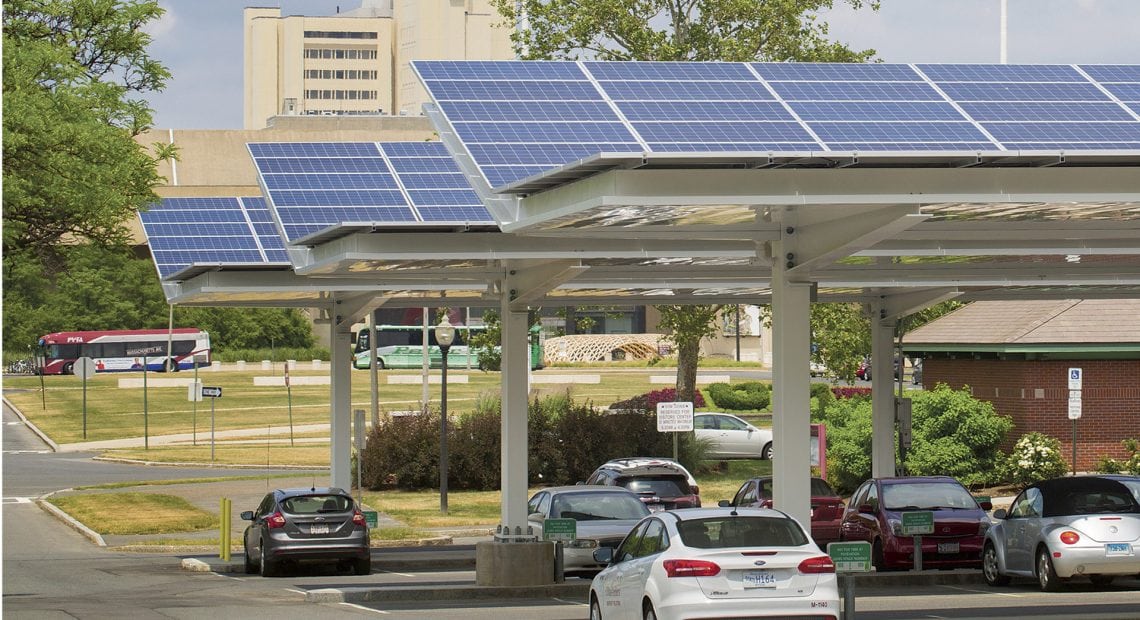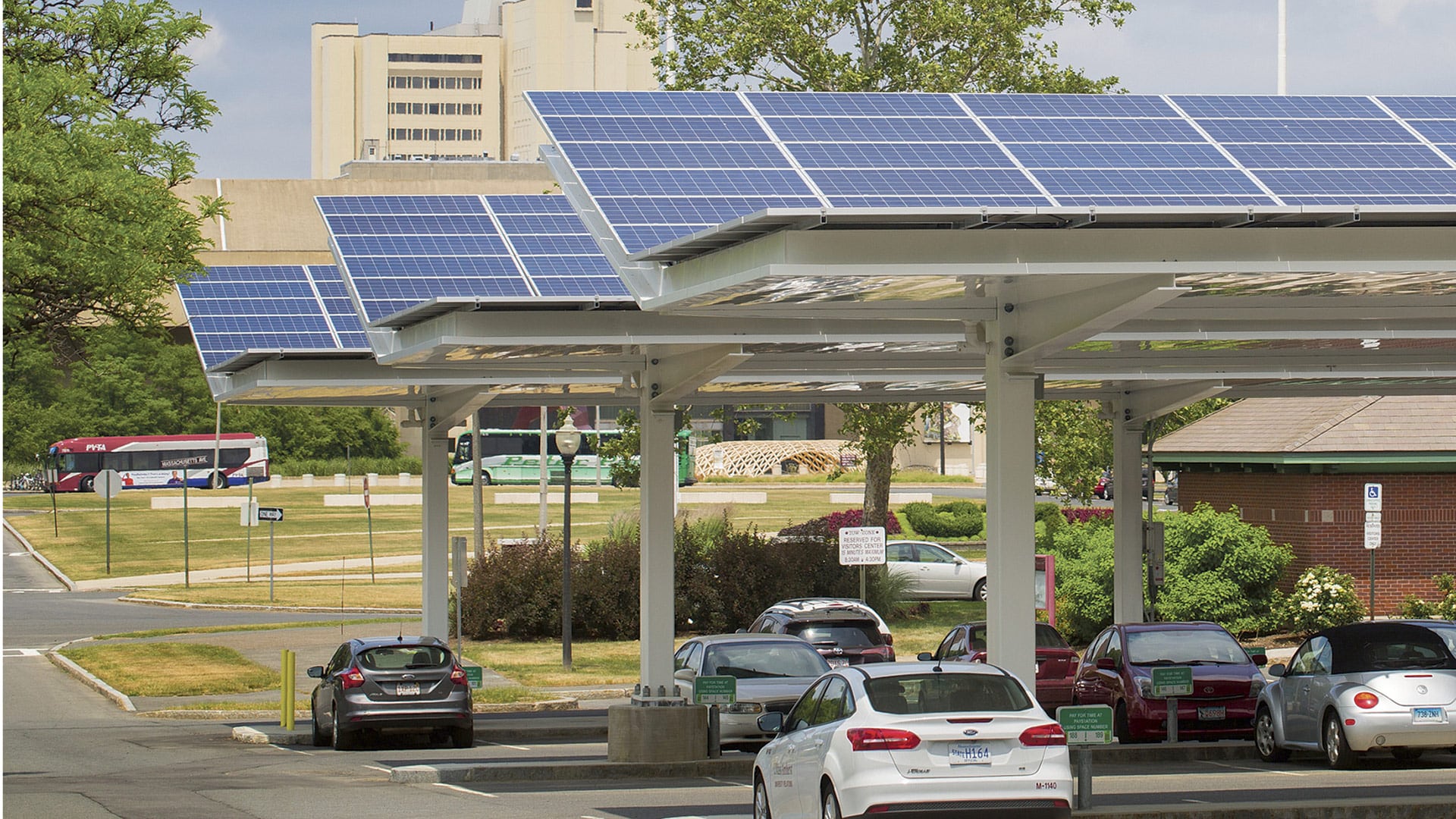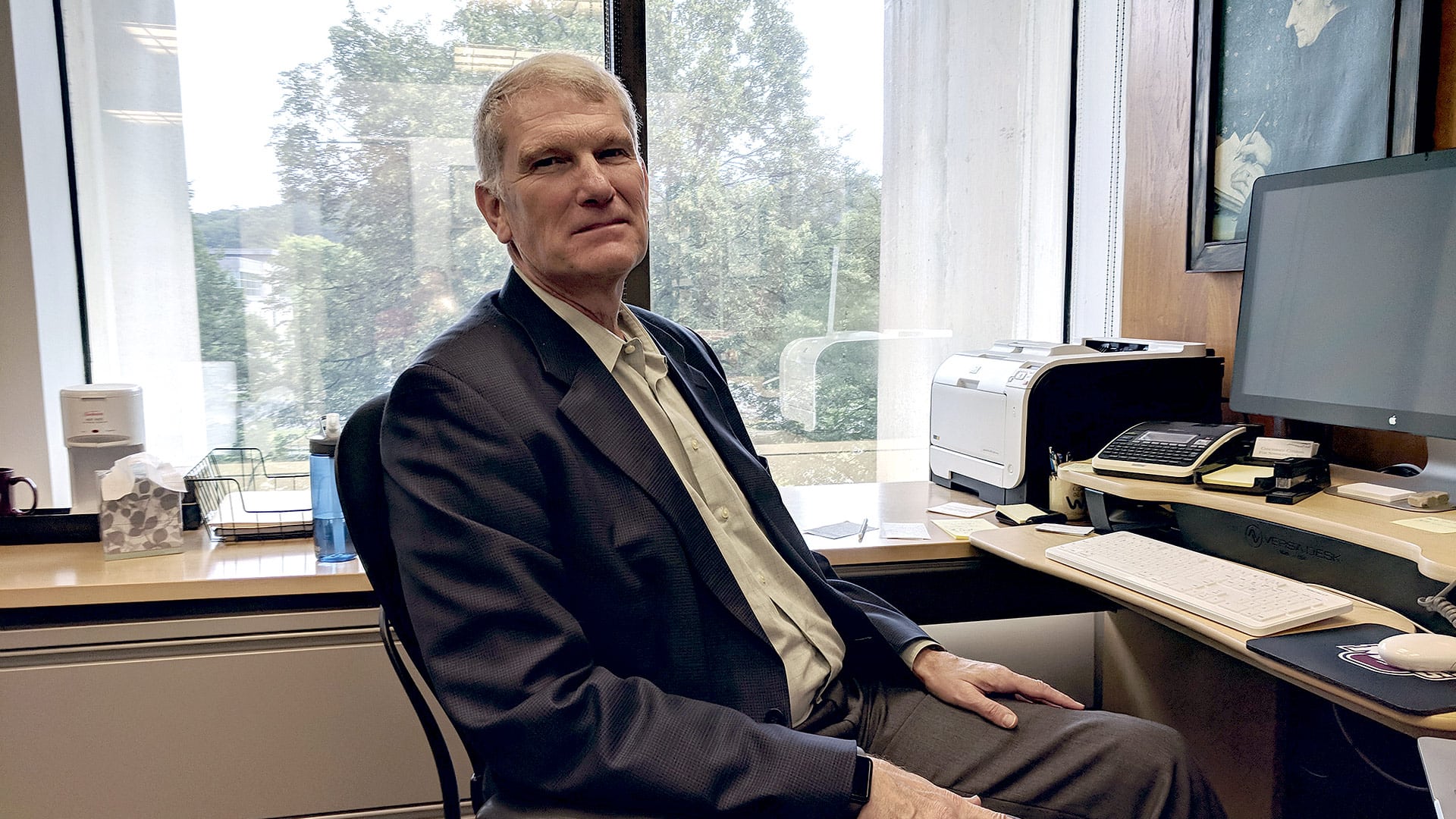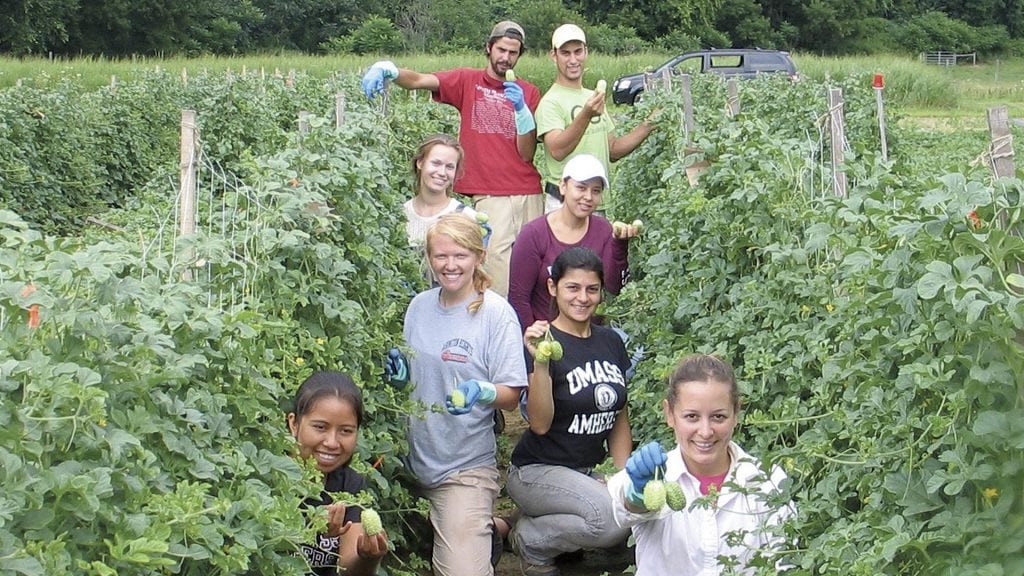
A Decade of Sustainable Practices Pays Off at UMass Amherst
Lean and Green

These solar canopies over a parking lot are part of a massive, campus-wide photovoltaic project.
Because its region is so environmentally conscious, UMass Amherst would appear to be fertile ground for sustainable practices like green energy, eco-friendly buildings, and a buy-local ethos in food service. But it’s still remarkable how broadly — and effectively — the university has cast its net when it comes to sustainability. A national report placing the campus ninth in the nation for such efforts is the latest accolade, but UMass isn’t about to rest on its laurels.
Call it a reward for a decade of work.
When the Assoc. for the Advancement of Sustainability in Higher Education released the three-year results of its Sustainability Tracking, Assessment and Rating System (STARS), UMass Amherst earned placed ninth in the nation — a leap of 20 places from its previous rating in 2015.
That’s gratifying, said Steve Goodwin, deputy chancellor and professor of Microbiology at UMass, who has been heavily involved in efforts to make the state’s flagship campus more green. And it’s not a recognition that was earned overnight.
“Sustainability has been a focus for the campus for about 10 years,” he told BusinessWest. “There were some efforts even before that, but it really started about 10 years ago.”
When Kumble Subbaswamy became chancellor in 2012, Goodwin said, he ramped up those efforts by forming an advisory committee specifically around sustainability, which helped to raise the awareness of green issues around campus.
“Sustainability has been a focus for the campus for about 10 years,” he told BusinessWest. “There were some efforts even before that, but it really started about 10 years ago.”
“This new STARS score reflects the university’s continuing commitment to excellence in sustainability,” Subbaswamy said when the ranking was announced. “UMass Amherst is a leader in best practices for energy-efficient construction and sustainable food use, conducting world-class research, and preparing a new generation of students to be inspired stewards of our planet.”
But before any of that could be accomplished — through innovative food-service changes, solar projects, green-building techniques, and a host of other initiatives (more on them later) — there had to be buy-in from both the university’s leaders and its students.
“It gained a lot of acceptance early on because a lot of sustainability is doing what you do and meeting your mission with very high efficiency,” Goodwin said. “That’s not all of what sustainability is, but that was an appealing piece for us. A campus has a particular mission, and it has a limited set of resources to meet that mission.”

Steve Goodwin says buy-in from students has been key to UMass Amherst’s sustainability successes.
Take, for example, the Central Heating Plant, a project completed in 2009 that replaced the campus’ 80-year-old coal-burning plant with a co-generation facility that provides electricity for 70% of the campus and 100% of the steam needed for heating and cooling buildings across the sprawling grounds — all while reducing greenhouse gases by 27%.
“That was a really big decision for the campus,” Goodwin said. “At the time, it was probably the best co-generation plant in the country. That really worked out well for us because we needed electrical power and we were heating with steam, so to get the efficiencies of co-generation was a really a big deal for the campus.”
Those early years of UMass Amherst’s new sustainability focus also saw a reduction in water use — by using recycled water where appropriate — and partnering with Johnson Controls to incorporate energy-saving devices on much of the campus lighting. And that was just the beginning.
“Since then, the sustainability committee has really taken the lead for the chancellor, and made it more of a campus-wide thing,” Goodwin said — in ways that continue to expand and raise the university’s green profile on the national stage.
Food for Thought
Early in the process, late last decade, UMass officials recognized food service as a prime area to boost efficiency and reduce waste. Not only did the sheer volume of food produced every day offer plenty of opportunity for improvement, but students were beginning to ask questions about waste.
“The initial step was to go trayless,” Goodwin said. “If you have a tray of food, it’s easier to heap a lot of food on the tray and not necessarily eat it all. But if you have to carry it all with your hands, you take less to begin with, and if you want more, you just go back.”
As a formal measure, in 2013, UMass Amherst became the largest food-service provider in the nation to sign on to the Real Food Campus Commitment, which requires participating universities’ food budgets to move away from industrial farms and junk food and toward local and community-based, fair, ecologically sound, and humane food sources by 2020. “For an institution this large,” Goodwin said, “we purchase a very large percentage of local food.”
In 2014, UMass Amherst Dining Services was selected as a gold recipient for procurement practices in the 2014 Sustainability Awards given by the National Assoc. of College and University Food Services — just one way national experts were taking notice. Around the same time, the university’s sustainability staff and faculty team from Environmental Conservation, the Physical Plant, Dining Services, and University Relations won the state Department of Energy Resources’ Leading by Example Award.

The UMass Crop and Animal Research and Education Farm in South Deerfield is home to the Student Farming Enterprise, which allows undergraduates to gain hands-on experience managing a small, organic farm. Produce generated there is sold to local stores and a community-supported agriculture share program.
Building design has been another focus, a recent example being the John W. Olver Design Building, completed last year, which uses a wood-concrete composite flooring product that was developed on the UMass campus. The contemporary wood structure, which houses the Building and Construction Technology program, the Department of Architecture, and the Department of Landscape Architecture and Regional Planning, includes sustainability features such as LED lighting, motion sensors, ample natural light, electro-tinting glass, heat-recovery systems, bioswales, rain gardens, low-flow faucets, and public-transportation access.
Meanwhile, the Integrated Science Building, constructed in 2009, employs cooling systems that reuse rainwater, state-of-the-art heat exchanges and ventilation systems, passive solar collection, and extensive use of eco-friendly materials like bamboo, to name just a few features.
“Obviously building is a big chunk of where our resources go, especially energy and water resources, so building design has a big impact,” Goodwin said, noting that UMass typically aims for some level of LEED certification on new buildings.
“But we’ve also done some things that go above and beyond those certifications to try to make our buildings more suited for their particular uses,” he went on. “There’s a whole variety of passive solar issues, lighting issues, energy and water use around buildings, reclaiming ground water, those sorts of considerations.”
Textbook Examples
On an academic level, Goodwin said, sustainability has made its way into the curriculum of nearly every program on campus. “I don’t think there’s any school or college that doesn’t have something that deals with an aspect of sustainability. They range from the obvious — an environmental science course, for instance — to a social justice course where they’re making connections back into sustainability and how that impacts the way people experience their communities.”
He stressed repeatedly, however, that raising up a culture of sustainability has never been a solely top-down effort, and that students have long been engaged on these issues.
“One of the things we did early on was to establish a culture within the dormitories and among the students — in part because the students really want this. They care about these issues a lot,” he said. “So we spend a lot of time building various aspects of sustainability into the curriculum, but also extracurricular activities.”
For example, ‘eco-reps’ are students who are specifically trained around issues of sustainability and are responsible for a floor of a dorm, to help students understand the impact of their day-to-day activities. “We run competitions between the dorms — who’s going to do the most recycling or use the least water this year, those kinds of things.”
Students had a direct impact on one of the university’s most notable green decisions — to divest its endowment from direct holdings in fossil fuels in 2016, becoming the first major public university to do so.

The John W. Olver Design Building is a model for green design and operation.
A year earlier, the board of directors of the UMass Foundation voted to divest from direct holdings in coal companies in response to a petition from the UMass Fossil Fuel Divestment Campaign, a student group. Energized by that decision, the campaign staged a series of demonstrations to call for divestment from all fossil fuels, and the foundation board followed suit.
“Important societal change often begins on college campuses, and it often begins with students,” UMass President Marty Meehan said at the time. “I’m proud of the students and the entire university community for putting UMass at the forefront of a vital movement, one that has been important to me throughout my professional life.”
It’s an example, Goodwin said, of the ways university leadership and the student body are often in alignment on issues of sustainability, both locally and globally. “So it’s been a balance of having sustainability in the curriculum, having demand from the students, and also having the central administration realize the importance of sustainability university-wide.
Numerous people on campus are tasked with making sure UMass continually improves its efforts, including the creation of a new position, sustainability manager, seven years ago.
“We’re having a huge impact in the region, and we’re proud of the impact we’re having — and at the same time, we’re also proud of what the students are experiencing,” Goodwin said. “Not only are they learning about these issues, but they’re living this approach as well. They’re living within an environment in which sustainability has a higher priority, so now we hope that impact will increase as they go out into their communities and spread the impacts of sustainability.”
Green Makes Green
Last year, UMass Amherst made news on the green-energy front again, installing more than 15,000 photovoltaic panels across campus, providing 5.5 megawatts of clean electrical power for the campus to use for a heavily discounted rate. The initiative is expected to reduce greenhouse-gas emissions in the regional grid by the equivalent of 31,000 tons of carbon dioxide and cut the university’s electric bills by $6.2 million over 20 years.
“It’s a situation where doing the right thing is also a very smart business decision as well,” Goodwin said. “As time goes on, some of those challenges will get to be a little trickier. Now we’re trying to make decisions about the need to increase the amount of electricity that we’re currently generating, so we’re going to expand the base, but how, exactly, is the right way to do it that’s efficient, a good financial decision, and also a good decision for the environment? It gets very complex.”
For now, he went on, the campus has a strong foundation in decreasing its carbon footprint and decreasing the amount of carbon dioxide and other greenhouse gases being emitted — efforts that have run the gamut from large-scale energy production to UMass Amherst’s participation in ValleyBike Share.
“The campus had been trying to run an internal bike-share program with some success, but we were hoping to do better,” he noted. “Now, with ValleyBike Share, the campus is working with other communities to develop a program that will actually bring a little more connectivitity between the university and the surrounding communities. So it has multiple benefits.”
Clearly, the impact of sustainable practices on not only the campus, but potentially the world, through the continued efforts of alumni, is reward enough for the university’s broad sustainability efforts — but the STARS recognition is nice too, Goodwin admitted, as it showcases UMass Amherst in the top 10 among some 600 participating institutions.
“We’re very excited about that, but it’s a huge amount of work, to be perfectly honest, because it’s all self-reporting,” he explained. “It covers so many aspects — the academic side, the financial side and investments, energy use, and the social side of sustainability. So it’s a very wide-ranging analysis. And, of course, after you do all that self-reporting, they go and verify everything as well.”
The end result is certainly a source of pride on campus — and a little more motivation to continue and broaden these efforts. Not that UMass needed any.
“Sustainability means a lot of different things to different people,” Goodwin said. “But to me, it was always a way of thinking: ‘OK, yes, we have a set of decisions to make; let’s make sustainability a part of that decision-making process.’ And I think our students are picking up on that as well.”
Joseph Bednar can be reached at [email protected]





